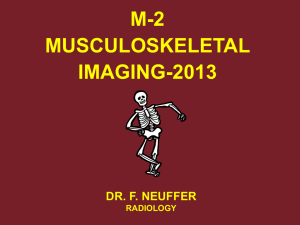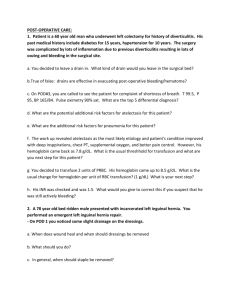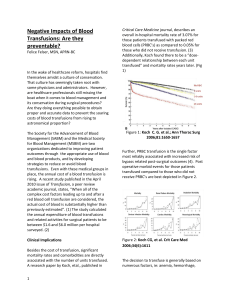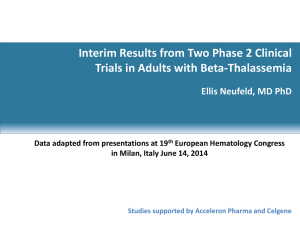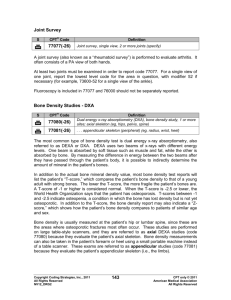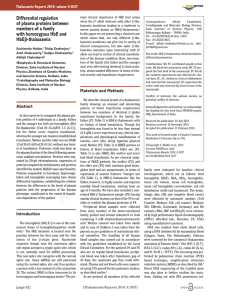Pain and Pain Management in Thalassemia
advertisement
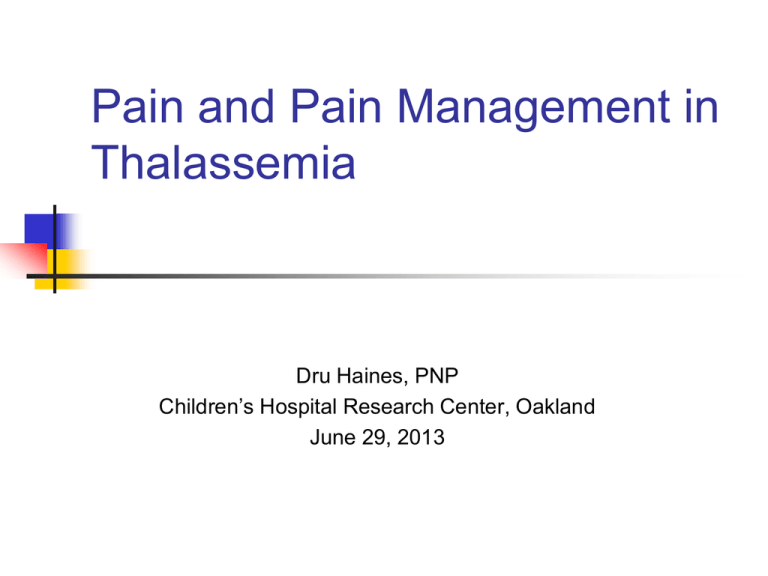
Pain and Pain Management in Thalassemia Dru Haines, PNP Children’s Hospital Research Center, Oakland June 29, 2013 Pain Questions How common is pain? How severe is pain? How prolonged is pain? What are the sites of pain? What is the cause of pain? How is pain managed? Who participated in the study? 252 patients with thalassemia. Age ranged from 12-71 Transfused and non-transfused -80 % transfused -6% intermittently transfused -15% non-transfused How common is pain? 64% of 252 participants reported experiencing pain in the last four weeks. 73% of participants 20 years old and older reported pain in the last four weeks. How common is pain? 26% of general US population of people 20 years old and greater reported pain in the last four weeks. How common is pain? Pain is more common in individuals with thalassemia vs. the US general population. How common is pain? 37% reported pain in the last seven days. 56% participants 35 years and older reported pain in the last 7 days. How common is pain? Pain significantly increases with age. Percentage of subjects (and 95% exact confidence interval) reporting pain by age (n=251) 100% 90% Subjects reporting pain 80% 70% 60% 50% 40% 30% 20% 10% 0% 12-13 (n=17) 14-17 (n=33) 18-24 (n=56) 25-34 (n=61) Age Group 35-44 (n=60) 45-71 (n=24) How severe is the pain? 81% rated their worst pain as moderate (4 or greater). 39% rated their worst pain as severe (7 or greater). How prolonged is pain? 81% reported pain for 1 year or more. 31% reported pain for 5 years or more. Pain Duration More than 5 years 25% 3 or fewer months 17% 5 years 9% 4 years 6% 4-6 months 4% 1 year 21% 3 years 6% 2 years 12% What are the sites of pain? 81% identified lower back. 47% identifed mid back. 39% identified upper back. Pain Sites Percentage of subjects (and 95% exact confidence interval) reporting pain by site of pain (n=92) 100% 90% 81.5% Subjects reporitng pain 80% 70% 60% 50% 40% 30% 55.4% 47.8% 47.8% 38.0% 38.0% 30.4% 20% 10% 0% Location 27.2% 28.3% What is the cause of pain? Participants reported the following causes of pain: -55% low hemoglobin -40% bone pain -30% muscle spasm What is the cause of pain? Analyzed whether the following were significantly different between participants with and without pain: Hemoglobin level. Bone Density severity, Fracture history. Iron overload. Chelation method. What is the cause of pain? None of the factors were significantly different. No clear pain cause identified. How is pain managed? 63% used pain medications Non steroidal anti-inflammatories-52% Acetaminophen (Tylenol)-34% Short-acting opiods-17% Long-acting opiods-8% How is pain managed? 47% reported decreased pain with blood transfusions. 43% reported decreased pain with rest. Summary of Findings Pain is common. Pain frequency and severity increase with age. Pain is chronic. Pain primary site is back. Pain etiology-elusive. Case Study I Ralph is a 49 year old male with Non transfusion dependent Beta Thal. Chronic back pain for greater than 10 years. Poor bone density, no history of fractures. Hemoglobin averages 10-10.5 Case Study Evaluation: Initial assessment pain located- along full length of spine. severity-7/10. radiates- intermittently down legs. numbness/tingling, loss of strength-not reported. Case Study I Further evaluation: MRI- Full Spine Orthopedic consult to assess for surgical options Case Study I Treatment Plan: Pain Medications: Non-steroidals, short-acting opiods, anti-anxiety Acetaminophen Case Study I Additional Therapies Initiation of transfusions recommended Physical Therapy Massage Exercise Case Study I Outcome Pain is decreased, but not eliminated. Case Study II 25 year old female with non transfusion dependent Beta Thal Intermedia 3-4 years Mild to Moderate mid back pain. Intermittent numbness in feet. Loss of ability to control foot movement. Hemoglobin averages 9.0. Bone Density low normal. Case Study II Evaluation: MRI of spine demonstrated two hemapoetic masses pressing on spine. Case Study II Treatment: Patient received radiation treatments to decrease the mass size. Patient started chronic transfusion therapy. Outcome: All symptoms resolved. Case Study III 47 year old female with transfusion dependent Beta thal. Lower back pain for 15 years. Pain increases prior to transfusion. History of vertebral fractures. Poor bone density. Scoliosis of mid back. Case Study III Initial Assessment: Pain Severity-7-10/10. Location-lower back. No numbness or tingling. Intermittent muscle spasms along spine. Case Study III Diagostic Imaging: MRI of full Spine. Further evaluation: Orthopedic consult. Pain Specialist referral. Case Study III Pain Plan: Medications: Short-acting opiods Non-steroidal anti-inflammatories- Pain Plan: Other Therapies Increased average hemoglobin level Physical Therapy Accupunture Massage Exercise Steroid injections Case Study III Outcome: Patient’s pain controlled, but not eliminated. What next? Further research: to clarify causes of pain, to improve pain management. Contributing Institutions Children’s Hospital & Research Center Oakland- PI-Dru Haines PNP, Olivia Oliveros Vega, Elliott Vichinsky,MD Children’s Hospital Los Angeles-Susan Carson NP, Thomas Coates, MD Children’s Hospital Philadelphia- Marie Martin RN, Sage Green, Janet Kwiatkowski, MD Children’s Hospital Boston- Jennifer Braunstein PNP, Ellis Neufeld, MD. Children’s Memorial Hospital Chicago- Diane Calamaras, NP Toronto General Hospital- Cecilia Kim BS, Nancy Oliveri, MD Weill Medical College of Cornell-Dorothy Klienert NP, Patricia Giardina,MD The Hospital for Sick Kids, Toronto- Manuela Merelles-Pulcini MSN Children’s Healthcare of Atlanta- LeAnn Schilling MPH Baylor College of Medicine- Bogdan Dinu, Stanford University- Michael Jeng, MD Children’s and Women’s Health Center, British Columbia- Jennifer Keis, RN New England Research Institute- Felicia Trachtenberg PhD, Eric Gerstenberger MS MD Anderson Cancer Center, Dept. of Symptom Research- Tito Mendoza PhD.
